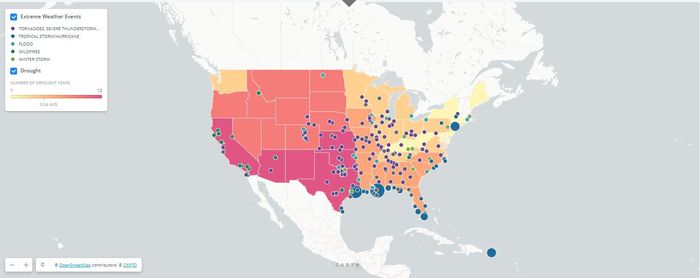The Texas electric grid operator called on companies and other consumers to voluntarily reduce power use on Monday as the risk of rolling blackouts from record-high demand to cool the state’s nearly 29 million residents intensified.
For sure, the Electric Reliability Council of Texas (aka ERCOT) is unique, as the power grid system runs outside the main U.S. grids. And an above-average heat wave was predicted to cook the state; Austin could hit a mercury-buster near 107 degrees Monday. Still, all Americans can learn from Texas about the fragility of a national power grid that is expected to be challenged more frequently by hot and cold weather extremes brought on by climate change — as well as by increased demand to power electric vehicles (EVs), more efficient heat pumps and more as part of a transition to a “greener” future.
Here are 5 things to know.
Why is Texas different?
ERCOT, the main Texas grid, is unique in its state-run, and not regional U.S., format used by the rest of the country. Because it’s an energy-rich state, Texas has been able to set power prices below those seen in other parts of the country, and its independence gives it more pricing authority. But during unfounded strain on the system, such as more people blasting their air conditioners longer to combat a record heat wave, it also has no where else to turn.
A deadly winter power shortage in February 2021 notoriously put the state and its independent utility in the spotlight when ERCOT failed to keep residents warm and pipes from bursting. Texas’s 2021 outage left more than 200 people dead and rang up $20 billion in damage. Fossil-fuel
CL00,
backers pointed to the rising use of intermittent wind power, which generates 23% of Texas’s electricity. Others said natural-gas machinery was frozen under the extreme conditions.
Read: The 10 most expensive climate-change disasters of 2021 cost $170 billion — and this U.S. storm was No. 1
This week, ERCOT is asking for voluntary conservation between 2 p.m. and 8 p.m. local time daily due to record high electricity demand from the projected heat wave, and also because of low wind. ERCOT said current projections show wind generation coming in at less than 10% of capacity. ERCOT stressed that no systemwide outages are expected, but it was acting preemptively.
A report late last year from the North American Electric Reliability Corp. (NERC) said the Texas system without upgrades could see a power shortfall of 37% in extreme winter conditions. NERC’s outlook suggested the state and ERCOT isn’t prepared for a repeat of weather extremes.
The typically temperate winter weather for much of the state left it unprepared for the shock of 2021; it is better prepared, state officials said at the time, to deal with heat. This week may test that claim.
Related: Texas power disaster may be strongest case yet for renewable energy
What energy sources create our electricity?
Natural gas
NG00,
is a main energy source to power electricity in Texas and elsewhere, replacing higher-polluting coal over several decades. Increasingly, wind power — especially in Texas, but elsewhere, too — and solar power is used for the electricity grid.
Read: Don’t rule out natural gas in the clean-energy transition, trade group says
Nuclear has been a small slice of American power, and advocates want more in use as the nation aims for zero greenhouse gas emissions in the coming years. Green hydrogen is also drawing investment to get up to scale.
A push to more renewable sources is seen vital to meeting a U.S. goal to half polluting emission by 2030 and hit net zero emissions by 2050, goals that are aligned with much of the rest of the industrialized world.
In 2021, emissions of atmosphere-warming CO2 by the U.S. electric power sector were about 32% of total U.S. energy-related CO2 emissions, the Energy Department says.
Trade groups and lobbyists from each energy source make their respective cases: green groups say the U.S. can’t switch to solar, wind
ICLN,
and hydrogen fast enough, while gas and oil interests say U.S. energy independence and costs to businesses and consumers matter, and they push for carbon emissions capture and storage and other still-young technology.
Price competition among traditional and alternative energy sources are getting closer to a level playing field. From 2009 through 2021, the prices of wind and solar power have decreased by as much as 72% and 90%, respectively, a report from Lazard found.
The Biden administration has set a goal of decarbonizing the U.S. power sector by 2035. Only recently, the Supreme Court ruled to limit the EPA’s role in combating climate change at power utilities.
Grid repairs are long overdue
Regardless of power source, the system itself is showing its age. The U.S. Department of Energy found that 70% of U.S. transmission lines are more than 25 years old in the agency’s most recent network-infrastructure review, held back in 2015. Lines typically have a 50-year lifespan.
The average age of large power transformers, which handle 90% of U.S. electricity flow, is more than 40 years, that report found.
Some estimates put the price tag on an electricity grid overhaul at upwards of $2 trillion. And agreeing on repairs is complicated by the web of state, regional and federal regulatory hurdles to consider.
EVs, heat pumps and more ‘green’ stress
Advocates for greater EV adoption
TSLA,
RIVN,
and swapping, for instance, gas-powered cook stoves and furnaces for electric options, realize any consumer-level “green” push will only be climate-conscientious if the electricity grid gets “greener” at the same time.
That means there are still growing pains when it comes to flexible use during peak and slower times, power storage and other factors.
According to Charles Kutscher and Jeffrey Logan, both of the Renewable & Sustainable Energy Institute at the University of Colorado Boulder, there are basically three ways to accommodate the variability of wind and solar energy when used for the power grid: storage, such as with lithium batteries; deploying power generation in a coordinated fashion across a wide area of the country along with more transmission; and managing electricity demand to better match the supply.
Transmission studies have shown that stronger interconnection among the country’s three primary power grids (there are seven grids in total) will be highly beneficial, as will making all our buildings, which use 74% of U.S. electricity, way more efficient.
If Texas and the rest of the nation want to reduce the risk of blackouts, growth in all these areas is essential.

Each circle shows at least one billion-dollar weather event, while red states reveal billion-dollar droughts, all between January 2000 and January 2022. Source: National Oceanic and Atmospheric Administration’s National Climatic Data Center and the Center for Climate and Energy Solutions.
Why do we have to prepare for more weather extremes?
No doubt, electricity has made our lives easier and extended how long we might live, period. But burning fossil fuels for power is heating up Earth, making the typical hurricanes, droughts, floods and extreme heat and cold more frequent, not to mention pushing into areas unaccustomed to temperatures challenging the top and bottom ends of a range.
It’s just this dangerous weather — aggravated by our electricity emissions — that puts added stress on the power grid. It’s a bit of a vicious cycle.
Scientists are detecting a stronger link between the planet’s warming and its changing weather patterns. Though it can be hard to pinpoint whether climate change intensified a particular weather event, the trajectory is clear — we are experiencing hotter heat waves, drier droughts, bigger storm surges and greater snowfall, the Environmental Defense Fund says.
Even snowier, colder winters like the storm that shocked Texas can be linked to global warming. Why? There is more moisture in the warmer atmosphere. So even when the temperatures are below freezing, snowfall or freezing rain can break records.
Plus, scientists are studying a possible connection between a warming Arctic and cold spells in the eastern U.S. The idea is that a rapidly warming Arctic can weaken the jet stream, allowing frigid polar air to travel farther south.
Read more about several types of extreme weather from the EDF.
